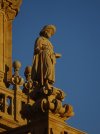As was mentioned above, my first Camino was in the spring of 1989 - not too far off from Bradypus. I was living in Madrid at the time and the first thing I did was go to the Spanish Tourism office to see what they had. I picked up a couple of brochures on the "
Camino de Santiago" (which, at the time, was synonymous with the
Camino Frances, or the
Camino Frances+Camino Aragones. No one was talking about the Camino del Norte, or the Camino Primitivo, or the Camino Portugues, or other Caminos in anything I could find at the time. Also of interest, perhaps, is that one of the brochures I was given (printed in the 70s) showed the Camino going along the roads and everywhere there was a gas station along the way. Even in the late 80s, it was not uncommon to find people driving the Camino instead of walking it. I will admit that the Camino I did then had a fair share of hitchhiking, as well as walking, unlike my subsequent Caminos. And many of the rides I got were from people on pilgrimage from Italy or Germany or elsewhere, driving along the Camino route from town to town and village to village.
I started in Roncesvalles, because I was coming from Madrid and from Spanish people, that's where I heard that the Camino started. When I got there I knew nothing about credencials, or the Compostela, or anything like that. I was given a credencial in Roncesvalles (which was a cardboard rectangle folded in half, specific to the Roncesvalles start point, with a limited number of spaces for stamps, each labelled with the town the stamp was to come from). The credencial came from the Friends of the Camino group in Estella. I never used it, not asked for my Compostela on that pilgrimage. That wasn't why I was doing the pilgrimage. I think I'm going to take it on my next
Camino Frances and see if I can fill in the stamps and what they will make of it in Santiago.
As others have said, there was a lot less infrastructure back then. I have vivid memories of arriving in O Cebreiro, cold and wet. This was before the albergue had been build and before it had turned into the tourist mecca it is today. There was one inn in the village and it was full. They let me lay my sleeping back down before the fireplace in the main room. I don't think I ever felt as much like a medieval pilgrim as I did that night. I later heard that sometimes they let pilgrims sleep in the thatched roof pallozas.
I recently went back and looked at some old photos from that pilgrimage and I was surprised to see how much infrastructure there actually was at the time. Others have mentioned that the yellow arrows were already in place. In fact, 1989 was the same year that the person who was responsible for those yellow arrows passed away. But that wasn't all the signage. I have photos of those huge signboards you may recall from Castilla y Leon showing the Camino through the province marked vertically. They were already there. And I have photos of an elaborate mosaic on the streets of Santo Domingo de la Calzada showing the Camino route.
Another big difference back then was how the Camino ended. Back then, you didn't enter the Cathedral in Santiago de Compostela like you do today, from the side. You entered through the Portico of Glory and you put your hand on the central Tree of Jesse pillar, in the grooves made by countless hands before you.

























